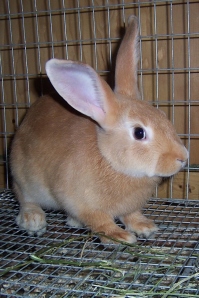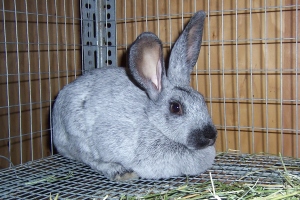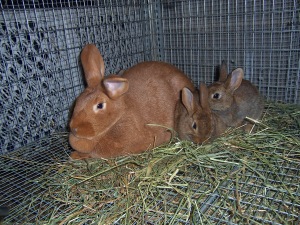This is the second post in our re-posting of our popular Managing Rabbits Series. In the first post we covered Housing and Feeding, which you can read by clicking here. To see the original posting of Managing Rabbits: Buying and Breeding from 2013 click here. There are slight changes to this post, but most of it is the same as the original.
Buying and Breeding
Now that we have discussed how we house and feed our rabbits at Willow Creek Farm, we will move on to buying breeding stock and breeding them.
When buying meat rabbits strictly for raising meat purposes it is not necessary to get show-quality rabbits. HOWEVER, when breeding animals it is always important to start with good, healthy stock or it could cause problems with your offspring. We never breed animals with obvious defects, such as their tail being way over to one side or droopy. While this probably wouldn’t affect our meat production, we don’t want to encourage bad genetic traits in our rabbits.
When we are looking at rabbits we hope to buy we always look at the health of the whole herd, not just the one we might buy. We look for any signs of discharge from eyes or noses. We look for shiny coats, clear eyes, obvious signs of healthy happy animals. We look at the living conditions the rabbits are in…are they clean? Have access to clean food and water? Have enough light? Are there a good number per cage, or are they overcrowded? Is the air fresh or heavy with ammonia? We have no problem walking away from a sale if the rabbits aren’t being raised right. There are plenty of rabbits available for sale and thus there is no reason to compromise on the health of the rabbit.
When buying new stock and bringing it home to our already existing herd we always quarantine the new rabbits for 4-6 weeks. That means they live in a cage in a separate building from where our rabbitry is. It also means we don’t feed, water, or handle the new rabbit and then go directly to the existing herd. We do the existing herd first, and then the new one – or we wash up between the two if we handle the new rabbit first. This is definitely extra work but it is oh-so-important. I have heard of people who lost their entire herd (almost 100 rabbits) to an illness brought in by one new bunny. Quarantine is necessary and important!
When we first decided to raise meat rabbits we went to the county fair and approached some 4H-ers in the rabbit area and started asking questions. We quickly found two girls, who showed their meat rabbits in 4H and had some young ones for sale. They had both Champagne D’ Argents and Palominos.
Because we raise our rabbits solely for meat and not show we almost always cross-breed them. This causes first generation hybrid vigor and our offspring grow faster and get bigger than either parent would. So we started with 2 Palomino does and 1 Champagne buck. That was years ago and our breeding stock has changed over time. Another breed we found and fell in love with along the way was Red New Zealands, again purchased from a 4H kid. Our current breeding stock includes a Flemish Giant/White New Zealand buck, two Rex/Silver Fox does, and a Palomino doe. All our breeding at this point is (obviously) cross breeding for hybrid vigor.
You would think that breeding rabbits went right along with the sayings about it and it would be simple and no big deal, but it’s not as simple as it seems it should be, and it takes first-timer rabbits (and people) a bit to get the hang of it. Once the rabbit has had a couple of successful breedings it becomes much easier and they know just what to do and get to it quickly and with no problems.
The first thing to be sure of is that both the doe (female rabbit) and the buck (male rabbit) are fully mature. This happens between 5 and 6 months of age in most breeds. If they are 5 months old and you put them together and things aren’t going as planned it might be that the buck isn’t ready yet. And if the buck does his job but the doe doesn’t get pregnant then it might be that the doe isn’t ready yet. It is good to wait until 6 months to be sure. Some people wait longer, but we have found with our does that when we have waited longer for a doe to have her first litter she ends up being less productive through her life and doesn’t get pregnant as easily. So we do our first breeding no later than 6 months of age.
The next thing to remember is that you ALWAYS put the doe into the buck’s cage – never the opposite. This has to do with territorial things and can lead to a big fight. If it is the first time a certain doe and buck are being bred with each other we like to have a squirt bottle of water with us and ready in case a fight breaks out – you can squirt them and it usually stops the fight long enough to grab the doe and get her out of there. But most fights are just spats and we have only needed the bottle once or twice because of major fights. Once the doe and buck are on their second or more breeding together this has been totally unnecessary as they know one another and seem to do fine.
Once you put the doe in the buck’s cage there will be quite a bit of running around (usually). They will do circles around the cage, or the doe will circle and the buck will sit in the middle spinning to try to keep up with her (which always makes me crack up laughing). Then the doe will eventually settle and lay out a bit and the buck with mount her. Now here is the strange part, that we had trouble with in the beginning – knowing whether the buck has finished his job or not. We had read that he will “fall” off or “pop” off of her back. Our first try ever the buck just kind of got off the doe and then the doe didn’t end up getting pregnant. The second time we ever bred rabbits we saw what they meant in the books we read. He will literally “pop” off of the doe (in a metal wire cage it is a loud noise as his back feet slap the wire hard) and sometimes he will fall over and just lay there like he is dead (but breathing, obviously). Funny, I know, but true. So if that doesn’t happen, then he didn’t finish his job and you need to let them keep going (unless he is young and then it might be that he can’t yet). Once he has finished his job we take the doe out and put her back in her cage.
There are many opinions about how often to breed or how long to leave them together. Some people leave them together for hours or even overnight. We have never done that. We have found the best results in size of litter and consistent pregnancies by breeding them once, putting her back in her cage, and then breeding them again 6-12 hours later and putting her back in her cage. Another thing we do to help increase pregnancy rates and litter size is to give all our rabbits apple cider vinegar in their water. We do 1 tsp per half-gallon. From what I understand this help with the ph of their bodies and that helps with pregnancy.
Over the years we have had a consistent average of 8 kits per litter from all our different pairings and breeds. We have, obviously, had litters with just 4, but have also had litters of 13, and overall when we look back on our records and do the calculations we have continuously averaged 8 kits per litter.
We have never tried to palpate our does to determine pregnancy at 14 days. I’ve been told it is difficult to tell for sure and that re-breeding them if you think they aren’t pregnant is risky because if they are pregnant and you just missed it, it can cause major problems. We might try it at some point, but for us we aren’t in a huge rush for them to reproduce because we are not a large-scale production business. So for us, waiting the extra two weeks to see if they give birth or not is no big deal.
The gestations we have had for Champagnes, Palominos, and Red New Zealands and any crosses of them is 31-33 days (from what I understand different breeds can differ slightly from that). Once we have them bred the waiting begins to see if the doe is going to kindle (give birth). And that is what I will talk about in my next managing rabbits post.




Thank you so much for this. We have all Californians and so far after 3 pregnancies, only one viable litter. They are now about 4 weeks old. How long do you leave them with the mother? And one only have one rabbit per cage. Is this okay? Still learning here! 🙂
LikeLike
Sorry to hear you have only had one litter work out. You can read about when and how we wean our kits by clicking on “managing rabbits series” on the right sidebar. Then scroll down to the post about weaning. Hope your rabbits increase their productivity!
LikeLike